A spiral slicer can be an essential tool in any kitchen, offering a creative and healthy alternative to traditional pasta and making beautiful garnishes for dishes. You must look for the blade quality, material, safety features, and ease of use. With so many options on the market, finding the perfect one that suits your needs can be challenging.
Types Of Spiral Slicers
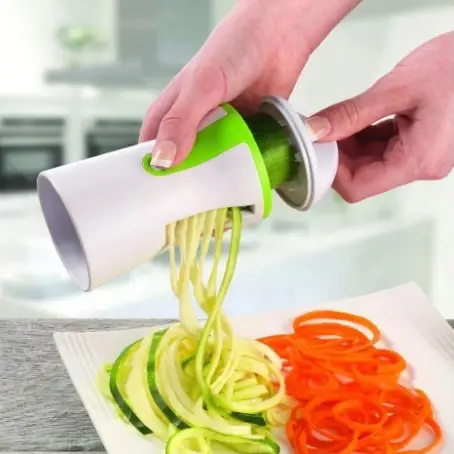
Handheld Slicers: Handheld spiral slicers are compact, budget-friendly, and easy to store. They typically require more manual effort and may not be suitable for large quantities of vegetables or fruits.
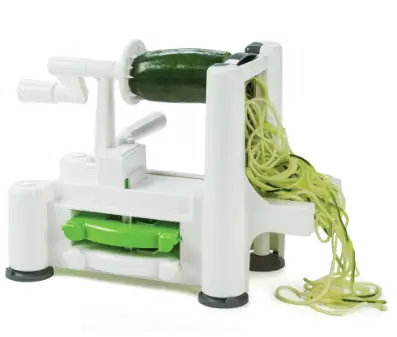
Countertop Slicers: Countertop spiral slicers offer more stability and are ideal for frequent use. They usually have a larger capacity and can handle different types and sizes of produce.
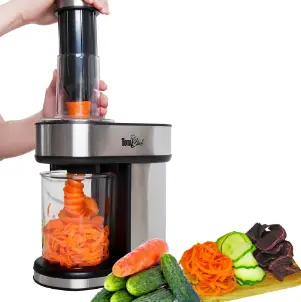
Electric Slicers: Electric spiral slicers are the most efficient and powerful, making them perfect for processing large quantities. They are more expensive but offer the best results and are the most user-friendly.
Material And Build Quality
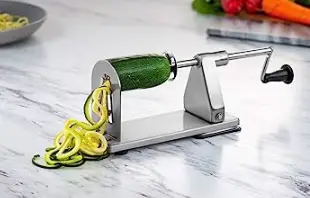
Stainless Steel: Stainless steel spiral slicers are durable, rust-resistant, and easy to clean. They often have a higher price point but are worth the investment for long-term use.
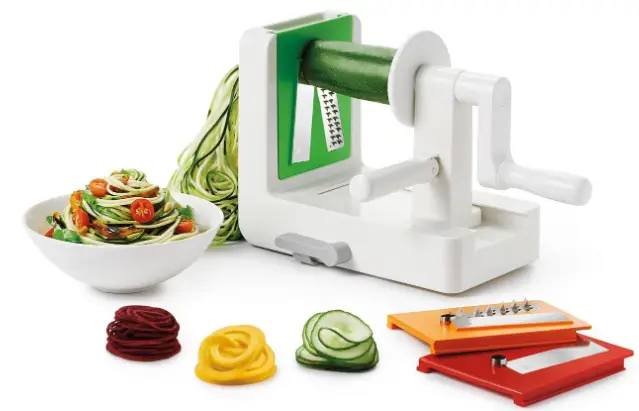
Plastic: Plastic spiral slicers are lightweight and generally more affordable. However, they may not be as durable or robust as their stainless steel counterparts.
Blade Quality And Versatility
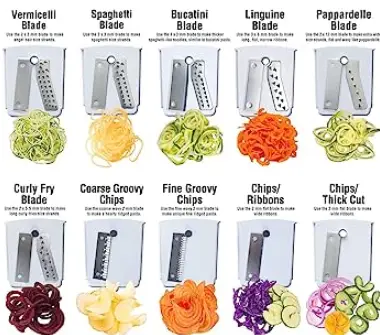
Blade Types: Different blade types allow for various cuts, such as spaghetti, fettuccine, or ribbon. Ensure the spiral slicer you choose has the blade options you need to achieve your desired results.
Blade Sharpness: A sharp blade is essential for clean, even cuts. Look for spiral slicers with high-quality, sharp blades that maintain their edge over time.
Blade Material: Stainless steel blades are the most common and provide excellent durability and sharpness. Some models may also feature ceramic or carbon steel blades, which can be equally effective.
Ease Of Use
Safety Features: Look for spiral slicers with safety features such as finger guards, non-slip bases, and protective covers to prevent accidents during use.
Ease of Cleaning: Choose a spiral slicer that can be easily disassembled and cleaned. Many models are dishwasher safe, making cleanup even more convenient.
Setup and Operation: Select a spiral slicer with straightforward assembly and operation instructions. User-friendly designs can make the process enjoyable and efficient.
Size And Storage
Compact Design: A compact design is essential for those with limited kitchen space. Look for spiral slicers that are easy to store and do not take up much room on your countertop.
Storage Options: Some spiral slicers come with built-in storage compartments for blades and accessories. This feature can help keep your kitchen organized and ensure you don’t lose any essential parts.
Brand Reputation
Reliable Brands: Invest in a spiral slicer from a reputable brand that produces high-quality kitchen appliances. Trusted brands often have better customer service and warranties, offering peace of mind in your purchase.
Customer Reviews: Read customer reviews to gauge the experiences of others who have purchased and used the spiral slicers you’re considering. These insights can be invaluable in helping you make an informed decision.
Warranty: Choose a spiral slicer that comes with a warranty or guarantee. This protection indicates the manufacturer’s confidence in their product and provides you with recourse if the slicer doesn’t perform as expected.
Price Range
Budget Options: Budget-friendly spiral slicers can be a great choice for those who don’t need all the bells and whistles or don’t plan to use the tool frequently. Be sure to consider the trade-offs in durability and performance.
Mid-Range Options: Mid-range spiral slicers offer a balance between affordability and quality. They often have more features and better build quality than budget options while remaining reasonably priced.
High-End Options: High-end spiral slicers have top-of-the-line materials, features, and performance. These models may be more expensive, but they are worth the investment for those who prioritize durability, versatility, and ease of use.
Popular Spiral Slicer Models
- Top Handheld Model: The OXO Good Grips Handheld Spiralizer is popular due to its compact design, ease of use, and affordable price.
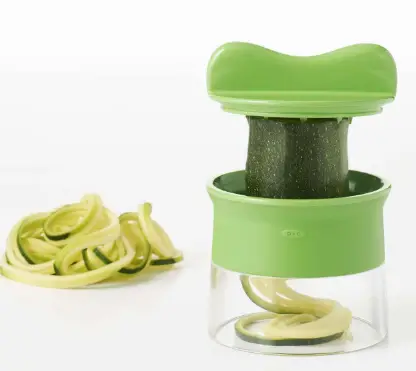
The OXO Good Grips Handheld Spiralizer - Top Countertop Model: The Spiralizer 5-Blade Vegetable Slicer is a top pick for countertop spiral slicers, offering various blade options, a stable design, and excellent performance.
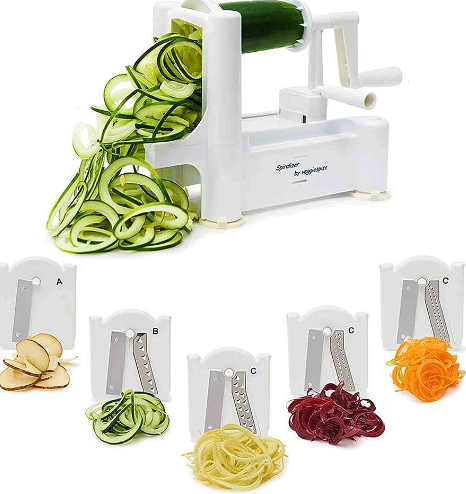
The Spiralizer 5-Blade Vegetable Slicer - Top Electric Model: The Presto SaladShooter Electric Spiralizer is a favorite among electric spiral slicers, known for its powerful motor, ease of use, and quick results.
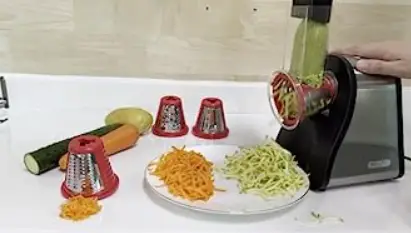
The Presto SaladShooter Electric Spiralizer
How To Use A Spiral Slicer?
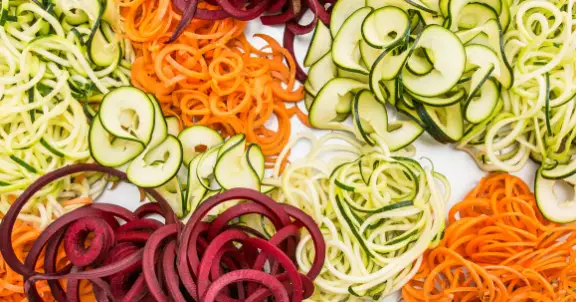
A spiral slicer is a versatile kitchen tool that allows you to create beautiful and healthy dishes with fruits and vegetables. Using a spiral slicer is generally simple and straightforward, regardless of your slicer type. Here are the basic steps to using a spiral slicer:
Step 1: Prepare the produce: Wash and dry the vegetables or fruits you want to spiralize before using your spiral slicer. Remove any stems or leaves, and peel the product if necessary. Cut the produce into shorter, more manageable lengths if it is long or uneven.
Step 2: Assemble the spiral slicer: Depending on your type of spiral slicer, you may need to assemble it before use. Follow the manufacturer’s instructions for setting up your slicer. Attach the appropriate blade for the desired cut (e.g., spaghetti, fettuccine, or ribbon).
Step 3: Secure the produce: Place the vegetable or fruit on the slicer according to the slicer’s design. For handheld slicers, insert one end of the product into the slicer and hold it securely. Secure the produce between the holding mechanism and the blade attachment for countertop slicers. For electric slicers, place the product in the feeding chute or attachment.
Step 4: Start spiralizing: For handheld slicers, apply pressure to the product while twisting it against the blade in a clockwise or counterclockwise motion. Keep twisting until the product is fully spiralized.
For countertop slicers, turn the handle to push the product towards the blade while holding the slicer steady with your other hand. Continue turning until you’ve spiralized the entire piece.
For electric slicers, turn on the machine and follow the manufacturer’s instructions to feed the produce through the slicer. The electric motor will do the work for you.
Step 5: Collect the spiralized produce: As you spiralize, the produce will emerge in long, thin strands or ribbons from the slicer. Collect the spiralized produce on a plate, cutting board, or directly into a bowl.
Step 6: Clean the spiral slicer: Disassemble the spiral slicer and clean the parts with warm, soapy water or in the dishwasher if they’re safe. Be sure to clean the blades carefully to avoid injury. Dry the parts thoroughly before reassembling and storing the slicer.
FAQs
Can spiral slicers handle all types of vegetables and fruits?
Most spiral slicers can handle a wide range of products, but some may have difficulty with very hard or soft items. Check the product specifications to ensure they suit the types of products you plan to use.
How do I clean and maintain my spiral slicer?
Disassemble your spiral slicer and wash the parts with warm, soapy water or place them in the dishwasher if they are safe. Dry the parts thoroughly before reassembling and storing the slicer.
Can I spiralize frozen vegetables?
It is not recommended to spiralize frozen vegetables, as they can be too hard for the slicer and may cause damage. Always use fresh produce for the best results.
How do I prevent my spiralized vegetables from becoming mushy when cooking?
To prevent mushiness, avoid overcooking your spiralized vegetables. Most only require a short cooking time to boil. Keep an eye on them and test for your preferred level of tenderness.
Are any recipes or guides available for using a spiral slicer?
Yes, numerous cookbooks, blogs, and websites are dedicated to spiralizing recipes and techniques. Many spiral slicer manufacturers also provide recipe ideas and tips with their products. Exploring these resources can help you get the most out of your spiral slicer and expand your culinary creativity.
Conclusion
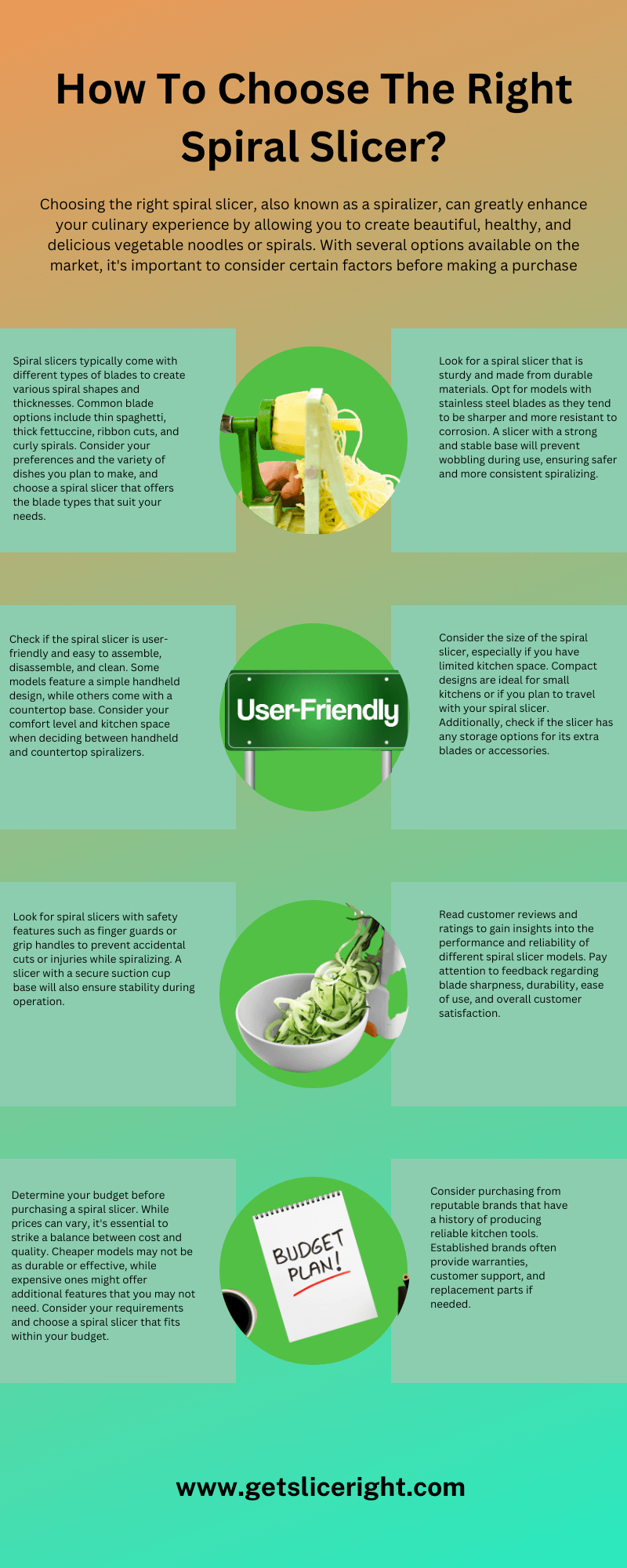
Choosing the right spiral slicer involves considering factors such as type, material, blade quality, ease of use, size, brand reputation, and price range. By carefully evaluating these aspects, you can find the perfect spiral slicer for your kitchen and enjoy its creative culinary possibilities.

Mario Batali is a renowned author, food enthusiast, and passionate chef who has dedicated his life to exploring the world of culinary arts. With a love for sharing his knowledge and experiences, Mario has become a prominent figure in the food blogging community, inspiring countless readers with his creativity and expertise.
In addition to his culinary prowess, Mario Batali is also a talented writer with a flair for engaging storytelling. He launched his own food blog to share his recipes, cooking tips, and personal experiences in the kitchen. Over time, Mario’s blog gained a loyal following of food enthusiasts who appreciate his unique approach to cooking and his dedication to using only the finest ingredients.
Mario Batali’s passion for food and his commitment to sharing his knowledge with others have made him a true inspiration in the world of culinary arts. Through his blog, cookbooks, and public appearances, Mario continues to spread his love of food and the joy of cooking with his ever-growing fanbase.







